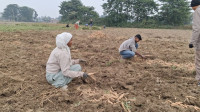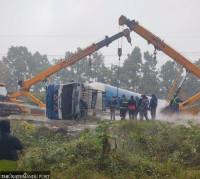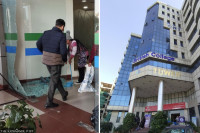National
Country’s northern and western places received ‘below normal’ rainfall this monsoon
As dry places receive less rainfall and southeastern parts witness above normal rainfall, experts say climate change is causing irregular rainfall patterns across the country.
Chandan Kumar Mandal
A majority of the country’s northern and western parts received relatively less rainfall in the last three months of the ongoing monsoon season.
The rainfall data released by the Department of Hydrology and Meteorology shows rainfall recorded this year, in most parts of the Karnali and Sudurpashchim provinces in the period of June to August, was 70 percent below normal rainfall levels, indicating a weaker monsoon in those parts of the country.
Normal rainfall of any place for any particular month is calculated as the average of the total rainfall received during a given month between 1981 and 2010.
The amount of rainfall a place receives is called ‘normal’ when the received amount of rainfall remains somewhere between 90 to 110 percent of the average rainfall, according to senior divisional meteorologist Indira Kadel, chief of climate analysis section under the department.
“Two provinces received below normal rainfall in the last three months. Some places in these two provinces had recorded as low as 50 to 60 percent of the average rainfall,” Kadel told the Post. “The less amount of rainfall obviously means a dry condition for the region.”
Data for the last three months shows that the two provinces have recorded ‘below normal’ monsoon this year, contradicting predictions that said these regions would receive more rainfall.
Weather experts from South Asian countries had said that Nepal’s monsoon rainfall is likely to be a mix of two patterns this year: below normal in provinces 1, 2, 3 and 5 and normal in other provinces, according to the consensus statement of the 14th session of the South Asian Climate Outlook Forum released in April.
However, the rainfall recorded so far has not been as predicted and has remained diverse across the country. While the northern and western parts of the country faced comparatively dry conditions this monsoon, other areas especially the southeastern parts of the country received excessive rainfall in the same period.
According to the department, southeastern parts, mainly Province 2 and low-lying places in southern parts of the Province 1, witnessed above normal rainfall, resulting in floods and inundation.
“Below normal rainfall was not recorded across the country, as previously estimated. In the southeastern region, the extreme rainfall that occurred on July 11-13 had contributed to extreme weather events in those areas,” said Kadel. “It has been scientifically proven that because of climate change there has been a rise in extreme weather events and irregular rainfall.”
This year, the seasonal flood, which was the result of extreme rainfall pattern in southern districts, wreaked havoc, claimed lives and destroyed property in the low-lying areas of provinces 1 and 2.
The highest precipitation in the last three months was recorded at 2888.2 mm in Lumle, Kaski, whereas the lowest precipitation stood at 105.8 mm in Jomsom, Mustang, according to the department’s statistics.
Udaypurgadhi in Udaypur recorded the highest 177.6 percent of normal rainfall and Jomson, Mustang, received only 19.7 percent of the normal average rainfall.
According to meteorologist Kadel, a trend observed in rainfall shows there has been a decrease in the number of rainy days or wet days since 2000.
“When we studied the number of days with a minimum 1mm rainfall for three consecutive days, we noticed that it had decreased,” said Kadel. Various studies have shown that the country is witnessing sporadic rainfall in recent years.
The monsoon, which delivers 80 percent of the country’s total rainfall, generally begins around June 10 and lasts until September 23. This year, however, monsoon got delayed and entered the country on June 20. Although at least 10 days remain for this year’s monsoon to end, meteorologists believe there is a slim chance of recovery for places with ‘below normal’ monsoon.
“If there is a spell of heavy rainfall like that of June this year, then those areas can recover,” said Kadel. “But the peak of monsoon season is July and August, and there is little chance of those areas receiving rainfall.”




 8.12°C Kathmandu
8.12°C Kathmandu













%20(1).jpg&w=300&height=200)

